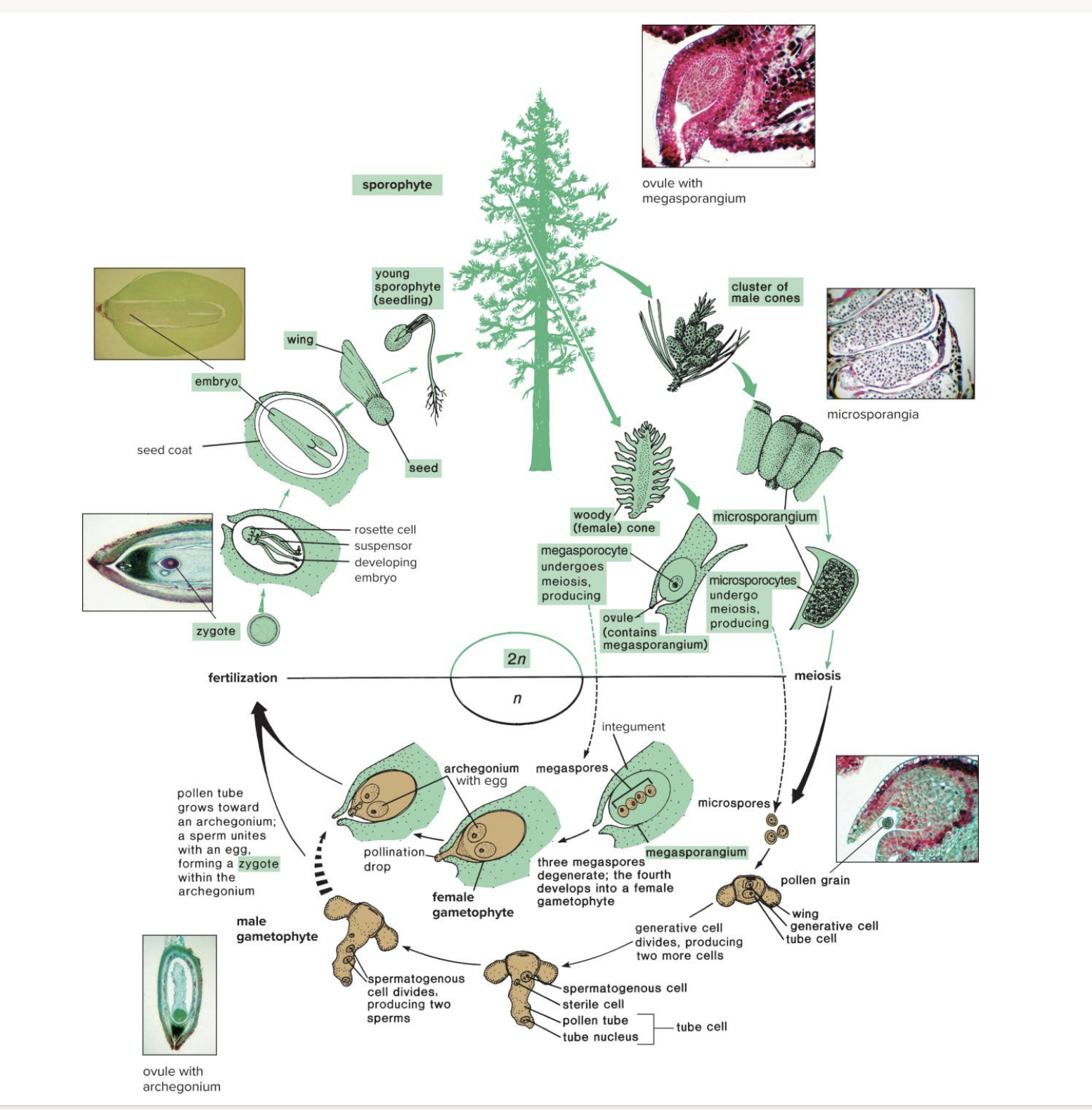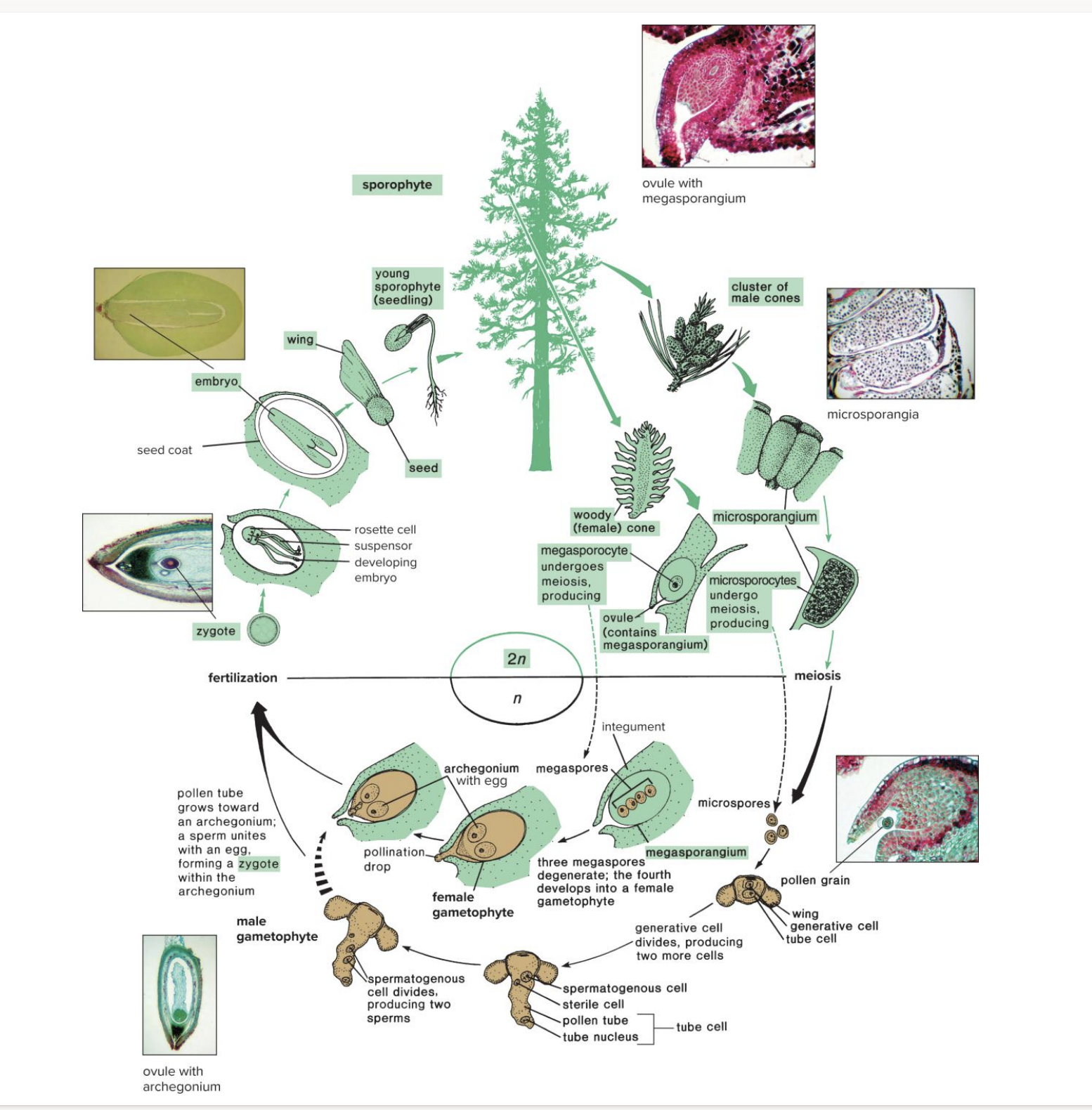Botany Gymnosperms
1/36
There's no tags or description
Looks like no tags are added yet.
Name | Mastery | Learn | Test | Matching | Spaced |
|---|
No study sessions yet.
37 Terms
Similarities with seedless vascular plants
Possess vascular tissue (xylem and phloem), true roots, stems, and leaves.
Advancements over seedless vascular plants
reproduction using seeds, water not required for fertilization
Advantages of reproducing via seeds
Contain well-developed multicellular your plant as compared to single cell spores, contain an abundant food supply, surrounded by a multicellular seed coat providing protection.
Gymnosperms ‘naked’ seeds
No ovary wall (fruit) surrounding seed: produced on surface of sporophytes, often on the scales of a cone.
Angiosperms seeds
Ovary wall (fruit surrounding the seed)
Gymnosperm seed anatomy
outside to inside: seed coat (from parental sporophyte), nutrition/food supply (from gametophyte), embryo (daughter sporophyte)
Gymnosperm leaves
megaphyll (many veins)
Gymnosperm phylums
Pinophyta, Ginkgophyta, Cycadophyta, Gnetophyta
Pinophyta- conifers
Most diverse phylum of gymnosperms, Linus is largest genus (dominant trees in northern hemisphere in coniferous forests), includes: bald cypress, yew, spruce, firs, Douglas firs
Pinophyta-leaves
Needle like arranged in clusters of two to five, cluster = fascicle, have resin ducts (resin is antiseptic and aromatic prevents fungi and insects), hypodermic located below epidermis, thick cuticle, recessed or sunken stomata.
fascicles
clusters of phinophyta leaves, short shoots, have restricted growth
Pinophyta-leaves-evergreen
held for 2-5 years (up to 30), water conserving adaptation, resins to deter herbivory and fungal attack.
Phinophyta-leaves-deciduous
bald cypress, dawn redwood, larch
Pinophyta- woody stems
Wood consists entirely of tracheids
Conifer wood
softwood- thick-walled cells (vessel elements) are absent
Broadleaf tree (dicot) wood
hardwood- thick-walled vessels and fibers present.
pinophyta- reproduction
Most are monoecious, generally borne as cones (strobili)
Monoecious
male and female reproductive structures present on different part of the same plant.
Pollen cones
male strobili, small, contain scales called microsporophylls, each microsporophyll has two microsporangia at the tip, inside microsporocytes undergo meiosis and produce 4 HAPLOID microspores which later develop into pollen grains.
pollen grains
immature male gametophyte, 2 prothallial cells, 1 generative cell, 1 tube cell, air sacs for wind dispersal.
Seed cones
larger than pollen cone, scales called megasporophylls, two megasporangia (ovules) at the base of each megasporophyll, megasporangium surrounded by integument (has a pore called micopyle), megasporocytes undergo meiosis and produce 4 haploid megaspores, 3 degenerate, 1 develops into female gametophyte with archegonia at micropyle end, nourished by the nucellus (provided by parental sporophyte)
seed cone maturation (year 1)
Pollen grains catch on sticky pollen drops from the micropyle, pollen grains produce pollen tube that grows through nucellus, pollen-sperm stuff, megaspore develops.
mature male gametophyte
germinated pollen grain with pollen tube and two sperm (sperm form from generative cell), sperm have no flagella and no antheridium is formed.
seed cone maturation (year 2)
Female gametophyte and archegonium mature, pollen tube arrives at archegonium, one sperm unites with egg, forming a zygote (other sperm degenerates), embryo nourished by female gametophyte, integument becomes seed coat, seed cones open to release the seeds.
Pinus life cycle

Yew (Taxus) and California nutmeg (Torreya)
produce ovules singly at tips of shoots, each at least partially surrounded by fleshy cupcake aril.
Junipers (Juniperus)
have seed cones with fleshy scales (appear as berries) (juniper berries)
Bristlecone pines
Oldest known living organisms (some over 4,000 years old)
Coast redwoods
tallest known organisms (some over 100 m tall)
Giant sequoias
Most massive living organisms (volume of 1,487 m³)
Gymnosperm evolution

Phylum Ginkgophyta
One species: Ginkgo bioloba, only exists in cultivation, deciduous, Dioecious, fleshy cones with a single seed, up to 19 species in fossil record going from 270 mya. Common in urban settings, tolerates air pollution, soil pollution, salt, and compaction, long-lived species.
Ginkgobiloba leaves
Broad, fan-shaped, notched, borne on short, slow-growing spurs, no midrib, dichotomous venation
Dioecious
male and female structures on separate trees
Phylum Cycadophyta
slow-growing plants of tropics and subtropics, tall unbranched trunks, crown of large pinnately divided leaves, similar life cycle to conifers, pollination mostly by wind sometimes beetles, dioecious (has pollen and seed strobili), sperm swims to female gametophyte, more prominent 250 mya, currently has around 140 species
Phylum Gnetophyta
Unique in having vessels in the xylem, more than half are species of joint fires (Ephedra) (shrubby plants of drier regions of southwester North America, South America, Asia, and Europe)
Phylum Genotophyta- Welwitschia
one species (Welwitschia mirabilis), in deserts of southwestern Africa, short stem, long taproot, only two traplike leaves that become tattered and split, dioecious, can be very long-lived (1000-2000 years), cones are insect pollinated (flies, bees, wasps)